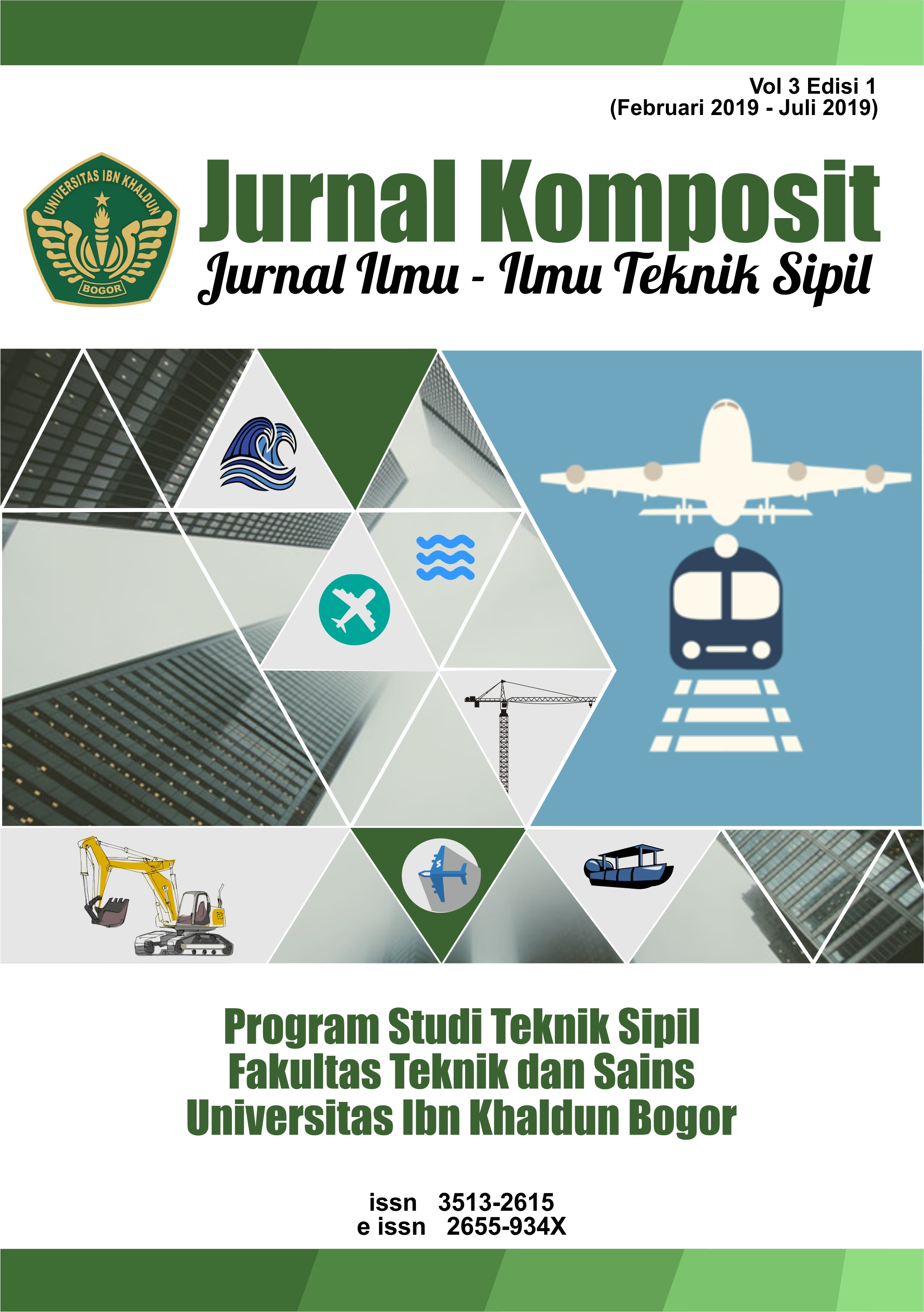EVALUASI BIAYA DAN WAKTU DENGAN METODE EARNED VALUE MANAGEMENT (Studi Kasus: Pembangunan Masjid AL-Hijri 2, Universitas Ibn Khaldun Bogor)
DOI:
https://doi.org/10.32832/komposit.v3i1.3744Abstract
Abstrak: Metode yang lazim digunakan untuk pengendalian biaya dan waktu banyak menggunakan metode konvensional seperti Kurva-S yang di dalamnya memperlihatkan keadaan sebagai berikut: tingkat capaian pekerjaan, dan tingkat prestasi kerjaserta penyimpangan jadwal pekerjaan. Dalam penelitian ini, metode earned value digunakan untuk mengetahui adanya penyimpangan varians biaya dan varians jadwal secara terpadu. Berdasarkan hasil analisis pada proyek pembangunan Masjid Al-Hijri 2 Universitas Ibn Khaldun Bogor dapat disimpulkan bahwa dari segi waktu, pelaksanaan proyek pembangunan Masjid Al-Hijri 2 pada minggu ke-8 ialah 12 minggu sesuai dengan waktu rencana yaitu 12 minggu, karena prestasi kerja di lapangan sama dengan target/rencana, dengan catatan jika prestasi kerja yang sudah dicapai dipertahankan sampai akhir proyek, ditinjau dari segi biaya, estimasi biaya akhir proyek sebesar Rp.1.026.278.400,00 sama besarnya dari biaya rencana yaitu Rp.1.026.278.400,00, dikarenakan harga aktual sama besarnya dengan harga perencanaan.
Kata Kunci: metode earned value, kurva-S, pengelolaan proyek.
Abstract: The method commonly used for cost and time control uses a lot of conventional methods such as the S-curve which shows the following conditions: level of job performance, and level of work performance and deviation of work schedules. In this study, the earned value method was used to determine the deviation of cost variance and schedule variance in an integrated manner. Based on the results of the analysis on the construction project of the Al-Hijri 2 Mosque at Universitas Ibn Khaldun Bogor, it can be concluded that in terms of time, the estimated time for completion of construction project in the 8th week is 12 weeks according to the planned time of 12 weeks, provided that the work performance that has been achieved is maintained until the end of the project, in terms of costs, the estimated final project cost is Rp. 1,026,278,400.00 the same amount as the planned cost of Rp. 1,026,278,400.00, because the actual price is the same as the planning price.Key words: earned value method, S-curve, project management.
References
Ervianto, W.I. (2004). Teori – Aplikasi Manajemen Proyek Konstruksi. Yogyakarta: Andi.
Febri E.R.D. (2014). Analisis Kinerja Biaya Dan Waktu Dengan Metode Nilai Hasil (EVM) pada Pekerjaan Renovasi Tahap II Asrama Wana Mulia SMK Kehutanan Samarinda. Jurnal Teknik Sipil dan Arsitektur. Vol 4 (1).
Flemming, Q.W., Koppelman. J.M., (1994). Earned Value Project Management, 2nd edition.
Kartikasari, D., (2014). Pengendalian Biaya dan Waktu Dengan Metode Earned Value. Jurnal Extrapolasi. Vol. 7 (2), Universitas 17 Agustus 1945, Surabaya.
Meliasari, I., dkk., (2013). Earned Value Analysis Terhadap Biaya dan Waktu pada Proyek Kontruksi. JeLAST: Jurnal Elektronik Laut, Sipil, Tambang, Vol. 2 (2). Universitas Tanjungpura, Pontianak.
Nugraha, P., Natan, I., Sutjipto, R., (1986). Manajemen Proyek Konstruksi I, Surabaya: Kartika Yudha.
Nugraha, P., Natan, I., Sutjipto, R., (1986). Manajemen Proyek Konstruksi II, Surabaya: Kartika Yudha.
Pamungkas, A., dkk., (2013). Analisis Nilai Hasil terhadap Waktu dan Biaya pada Proyek Kontruksi. Jurnal Matrik Teknik Sipil Vol. 1 (4), Universitas Sebelas Maret, Surakarta
Pandeiroth, Y.C.S., Sompie, B.F., Tarore, H. (2012). Kajian Penerapan Earned Value Management System (EVMS) pada Kontraktor Jasa Konstruksi di Kota Manado. Media Engineering V0l. 2 (3). 197 – 207.
Ramdhani, F., (2016). Analisis Biaya Dan Waktu Dengan Metode Earned Value Concept pada Proyek BJDM Area RL Construction at Well 3S-21B Area 9 PT. Adhi Karya CS Work Unit Rate Packagea – Duri. Racic: RAB Construction Research 1 (01), 17-35, Universitas Abdurrab, Pekanbaru.
Sutoyo. S., 2000. Pembiayaan Investasi Proyek (capital budgeting) Edisi pertama, Jakarta: Damar Mulia Pustaka.
Downloads
Published
How to Cite
Issue
Section
License
Authors who publish with this journal agree to the following terms (Penulis yang mengajukan publikasi artikel telah menyetujui hal berikut):
- Through this publication, the author agree to submit the copyright of article writing to Jurnal Komposit: Jurnal Ilmu-ilmu Teknik Sipil. This copyright submission takes the form of, but is not limited to: reproduction of the article and parts therein, including photographic reproductions; distribution of articles through printed and electronic documents; and translation of articles(Bahwa melalui publikasi ini, hak cipta penulisan artikel diserahkan kepada Jurnal Komposit: Jurnal Ilmu-ilmu Teknik Sipil. Penyerahan hak cipta ini berupa, namun tidak terbatas pada: perbanyakan artikel dan bagian di dalamnya, termasuk reproduksi fotografi; penyebarluasan artikel melalui dokumen cetak dan elektronik; serta penterjemahan artikel).
- The authors agree to the terms of the Copyright Notice, according to Creative Commons Attribution-NonCommercial-ShareAlike 4.0 International License., which will apply to this article if and when it is published by Jurnal Komposit: Jurnal Ilmu-ilmu Teknik Sipil. (Para penulis setuju dengan ketentuan Pemberitahuan Hak Cipta, sesuai dengan Lisensi Internasional Creative Commons Attribution-NonCommercial-ShareAlike 4.0., yang akan berlaku untuk artikel ini jika dan ketika diterbitkan oleh Jurnal Komposit: Jurnal Ilmu-ilmu Teknik Sipil).

This work is licensed under a Creative Commons Attribution-NonCommercial-ShareAlike 4.0 International License.



.png)










